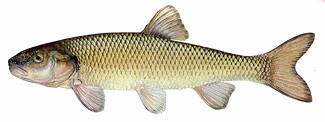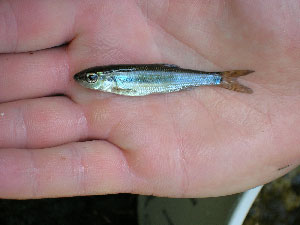Fallfish
Semotilus corporalis
 Distribution: Fallfish range from eastern Canada south to Virginia, east of the Appalachian Mountains. Fallfish are common throughout New Hampshire.
Distribution: Fallfish range from eastern Canada south to Virginia, east of the Appalachian Mountains. Fallfish are common throughout New Hampshire.
Description: A thick bodied minnow with large, silver, metallic looking scales that overlap in half circles. The snout extends slightly beyond the upper lip. The mouth terminates at the front end of the eye, which is relatively large. There is a small barbell attached to the groove at the corner of the mouth, but it is absent or difficult to see in some individuals. Young fallfish appear to have a dark lateral band which can make them difficult to distinguish from other juvenile minnows. Common shiners, unlike fallfish, have diamond shaped scales which slough off easily and become crowded just behind the gills.
Species commonly confused with: Common shiner, creek chub
Habitat: Fallfish are a habitat generalist and can be found in nearly any freshwater habitat, though they are most abundant in rivers and streams with a mix of rocky and gravel substrates.
Life History: The fallfish is New Hampshire’s largest native minnow species and one of the most common fish species in the state. It can grow to 10 inches (255 mm) in length and live for over 10 years. Fallfish males build nest mounds out of pebbles, one stone at a time. Spawning is communal, although usually initiated by the nest builder, with a number of females and surrounding males using a single nest. Larger individuals may move into smaller streams to spawn. Their abundance and wide distribution make fallfish an important source of forage for both aquatic and terrestrial predators.
Origin: Native

Conservation/Management: There are no specific conservation or management objectives for fallfish. As habitat degradation and climate change cause warmer average water temperatures in the rivers in streams of New Hampshire, fallfish may expand into habitat historically occupied by brook trout. One of the objectives of the NHFG Fish Conservation Program is to collect baseline fish community data for monitoring long term trends in the abundance and distribution of New Hampshire’s freshwater fish species, which will reflect changes in aquatic habitat and water quality across the state.



